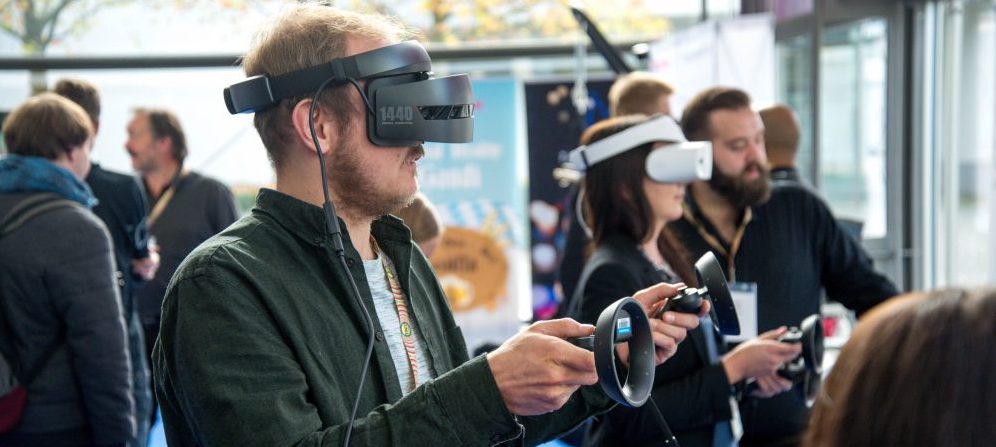We’ve all seen examples of virtual or augmented reality, or at least can conjure these images: a person wearing a virtual reality headset grabbing at air to fight what we can only imagine are flesh-eating zombies or craning their neck at the ceiling to get a full view of the Milky Way; using a Snapchat lens to transform into a panting dog, a form of augmented reality.
When I call to mind these images, I can’t help but consider the potential workplace applications for the tech driving these experiences.
What is XR?
These examples all fit into the bucket of tech collectively known as extended reality (XR), an umbrella term used to describe virtual reality (VR), augmented reality (AR), and mixed reality (MR). VR is an entirely immersive experience that removes the physical world from view; AR is a technology where virtual images are overlaid onto our physical world; MR is a newer form of tech where an altered reality allows users to interact with virtual objects in a real-world environment.
XR @ Work
Changing How We Train
Research shows people remember information better if it’s presented to them in a virtual environment. When this information is considered through the lens of effective employee education, integrating XR into training programs seems to make sense. And, it’s not just happening, it’s proving to be effective in industry, showing increases in retention rates of employees and workplace productivity. Agencies within the U.S. government have also jumped on board to use XR and use cases are expected to grow in 2021.
As examples, NASA has a virtual reality lab to support astronaut training and the Department of Agriculture’s Food Safety and Inspection Service uses XR for recruitment. GSA, via Digital.gov, launched the Virtual and Augmented Reality Community, a collaborative hub for the research and refinement of VR and AR business cases and pilot programs across government.
Applied to your career, you might envision a future where you hone your employee evaluation skills and practice difficult conversations with employees wearing a VR headset, refine your presentation techniques in front of a virtual audience to overcome stage fright, and use AR to follow instructions to set up your new laptop—hands-free sporting “stylish” Google Glass. All sound pretty useful, right?
Transforming the Way We Collaborate
Another way XR is likely to permeate your workplace is through collaboration platforms. As more and more employees are on the go using mobile devices to connect with colleagues and remote work becomes more common, employers are exploring how they can reinvent meetings. AR collaboration platforms could be the next phase in conferencing, providing in-office and remote users with the ability to collaborate, search, brainstorm, and share content as if they were in the same room.
XR and Inclusion
In addition to enhancements in training and collaboration, XR technologies have the potential to create inclusive workplace environments, specifically removing barriers for people with disabilities to enter and engage in the workplace. A person with a limited mobility, for instance, may not be able to work effectively in a traditional office setting. AR could provide an opportunity to join an in-person meeting through a virtual avatar or offer a person who is deaf or hard of hearing with real-time captioning through transparent glasses during discussions with colleagues.
XR is also being used for diversity and inclusion training, allowing employees to experience how a person from an unrepresented community might encounter discrimination and learn ways to identify and address biases.
Now What?
Tips to help you prepare for XR in the workplace:
- Learn more about current use cases of XR in the workplace, gaining insight into how XR could impact your office and Government agencies more broadly and check out this article by GovLoop contributor Zackary Rettig – “8 Areas of Progress and Improvement in Government Tech.”
- Prepare for what’s coming, considering how you can create a working group in your office to explore potential uses for XR on your team and sketch out a plan for future integration of emerging tech!
Join the Digital.gov Virtual and Augmented Reality Community open to Government employees. - Oh, and read my post next week for more on XR and inclusion!
Devin Boyle is a GovLoop Featured Contributor. She is a Senior Consultant at Wheelhouse Group supporting the Partnership on Employment & Accessible Technology (PEAT) as Emerging Technology Lead and acting as Adviser to XR Access. An experienced communicator and avid writer, she has authored articles for national, local, and trade publications to advocate for societal change and social inclusion for vulnerable populations. She believes in the benefits of preparation before execution and the personal and professional power of Mindful Self-Compassion practice. She lives with her partner, dog, and one-eyed cat in Arlington, VA.





Wow, very insightful! I appreciate you addressing how XR can affect the workplace.